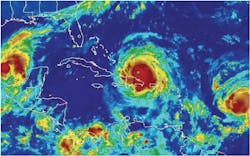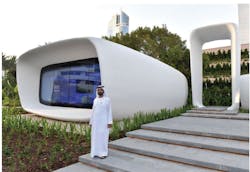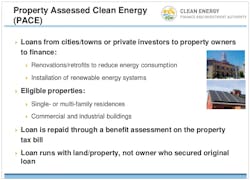1. CLIMATE CHANGE IS ONLY GETTING WORSE
The U.S. Global Change Research Program (USGCRP) recently released its 2017 National Climate Assessment. Not surprisingly, the report concluded that there was extensive evidence to support the theory that human activities are primarily responsible for climate change. As a sustainability professional and 10-year barrier island resident in South Florida, I am extremely concerned about the warming sea water temperatures and rising sea levels. Last September, I experienced my first major hurricane, Irma, about which I wrote in a column entitled “Winds of change: Are more intense storms the new normal? In 2018, I would expect to see the frequency and intensity of daily tidal flooding continue to increase, especially on the East and Gulf Coasts. The USGCRP report pointed out that the past three years have been the warmest ever recorded and I would expect that trend also to continue in 2018.
2. GREATER FOCUS ON BETTER WATER CONSERVATION
Although states like Texas and Florida have had extreme rain events, resulting in serious flooding, other states – California in particular – have had prolonged droughts. In 2018, I expect to see a significant increase in water conservation initiatives, such as more stringent requirements for water efficient fixtures and appliances; more use of recycled/reused/reclaimed water; increased utilization of rainwater harvesting; and new/improved technlogies for smart irrigation controls and groundwater management.
3. EVEN MORE HIGHER EFFICIENCY HVACR PRODUCTS
In 2015, the Financial Stability Board (FSB) – an international body representing more than 20 countries and the European Union that monitors and makes recommendations about the global financial system – established a Task Force on Climate-related Financial Disclosures (TCFD). The TCFD was charged with developing recommendations for climate-related disclosures that could “promote more informed investment, credit, and insurance underwriting decisions.” In addition to identifying climate-related risks, their 2016 report outlined a number of climate-related opportunities in a number of industries. These included transporation, building, energy production, and consumer products. In 2018, with the widespread recognition by the financial community of the need for accelerating the development of new energy efficiency technologies in order to mitigate climate-related risks, I expect to see increased investment in emerging low-carbon technologies and more funding specifically focused on developing higher efficiency HVACR products.
4. MORE 3D PRINTING IN CONSTRUCTION (AND EVERYWHERE ELSE)
Most of us have read or heard on the news – or seen on TV doctor shows – about 3D printers bioprinting human cells and tissues. What hasn’t been quite as newsworthy, except perhaps in the United Arab Emirates, is the use of 3D printers in construction. Last year, the first fully functional office building was 3D-printed (in only 17days) in Dubai, and there are plans to “crane print” a skyscraper there. Also last year, here in the U.S., MIT researchers published the details of their Digital Construction Platform (DCP), a robotic system that used 3D printing technology to build – in less than 13.5 hours – a dome-like structure approximately 48-ft (14.6 m) in diameter and 12-ft (32.7 m) high. One of DCP’s tools sprays building materials (in this case, a foam) much like a conventional 3D printer. However, because it’s free moving, it is not limited in the footprint of the structure it can build.The team also left the door open for solar PV-powered systems in the future, so that it could be used in locations where electric utility infrastructure are either not yet in place or not functioning (such as after a natural disaster). Other noteworthy 3D-printed construction projects include a startup’s robot 3D printer and approximately $10,000 (USD) in materials to build a 400-sq-ft house in Russia earlier this year, and in 2015, Oak Ridge National Laboratory’s 3D printer efforts – although primarily focused on additive manufacturing – included a 200-sq-ft concept home and its 3D-printed compatible car that communicated wirelessly with the house. And I would be remiss if I didn’t mention the Shorewood, MN, contractor who – when he couldn’t find a large enough tree for the fort he wanted to build – built his own 3D printer to print a castle using mostly play sand and cement to create the material for his extruder. Other innovative uses of 3D printers include McLaren Racing’s printed race car wing and the Adidas-printed Futurecraft 4D shoe, which some lucky runners should get for Christmas! (Mass production starts next year.) So, for 2018, I predict a huge upward trend in new and expanded applications for 3D printing.
5. MORE CLEAN ENERGY FINANCING
PACE, or Property-Assessed Clean Energy, has long been a personal and professional interest of mine. It’s been around since 2008, when the first program started in Berkeley CA, and is now available in more than 30 states. Because of pushback from traditional mortgage lenders, it has only recently gained real traction, in spite of the fact that Scientific American magazine (the oldest continually published monthly magazine in the U.S.) called it one of the top 20 “world-changing” ideas. PACE provides financing for qualifying improvements to both commercial and residential properties. Qualifying improvements are those permanent improvements to a property that increase energy efficiency; provide renewal energy (solar thermal or photovoltaic, wind turbines, etc.), and – in some states – reduce water consumption. Florida’s PACE enabling legislation also permits PACE financing of windstorm (hurricane) resistance improvements (roofs, impace windows and doors, etc.) and California’s programs will fund seismic-hardening improvements. What makes PACE so unique is that the loan is tied to the property, not to the property owner. The loan is based on the value of the property and the cost of the improvements, rather than on the credit-worthines of the owner, and is repaid as a special, non-ad valorem tax assessment. For commercial property owners, it is true “off-book” financing with no personal guarantees required. That’s reflected in the cumulative investment of more than $340 million in commercial PACE loans so far, a number that is trending strongly upwards. In 2018, look for significantly more PACE projects, both commercial and residential, as the word gets out.
A regular contributor to HPAC Engineering and a member of its editorial advisory board, the author is a principal at Sustainable Performance Solutions LLC, a south Florida-based engineering firm focusing on energy and sustainability. He can be reached at [email protected]. (This article first appeared in the December 2017 print edition of HPAC Engineering magazine.)












